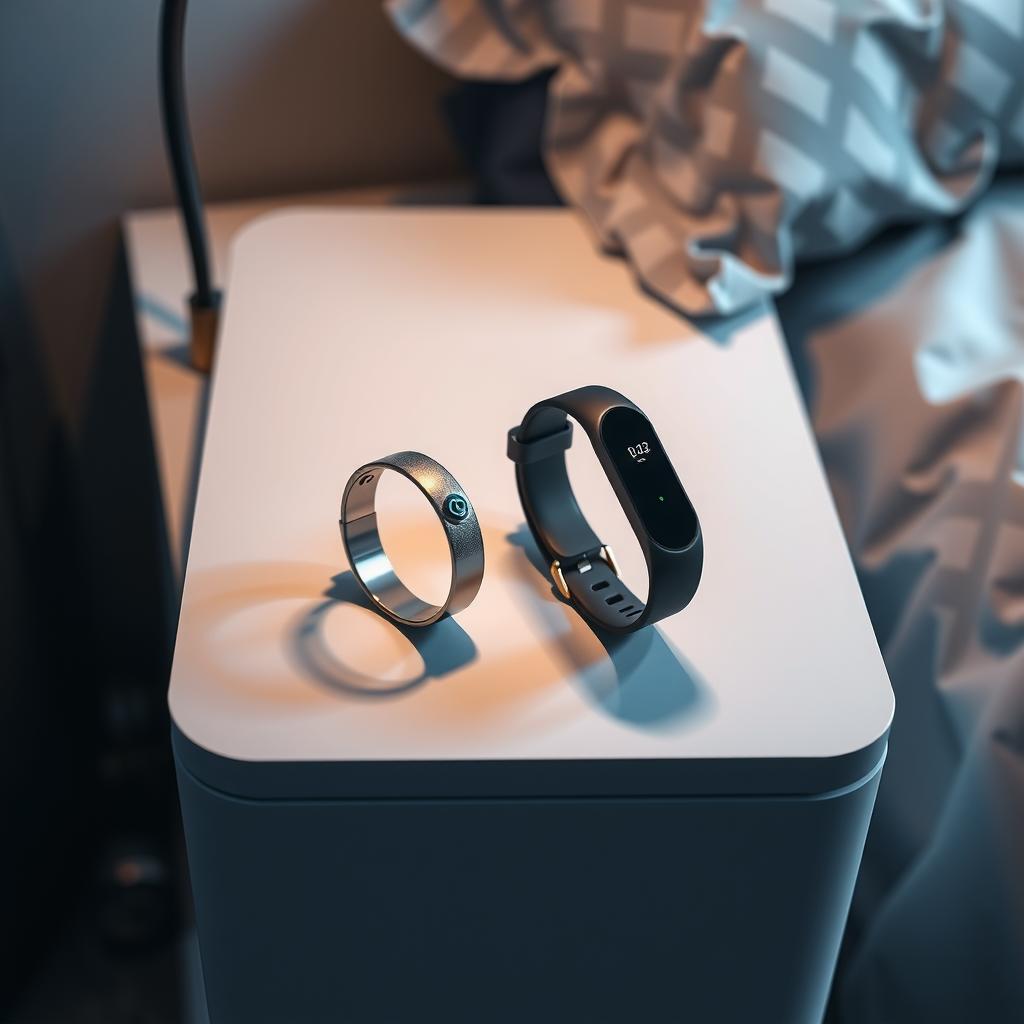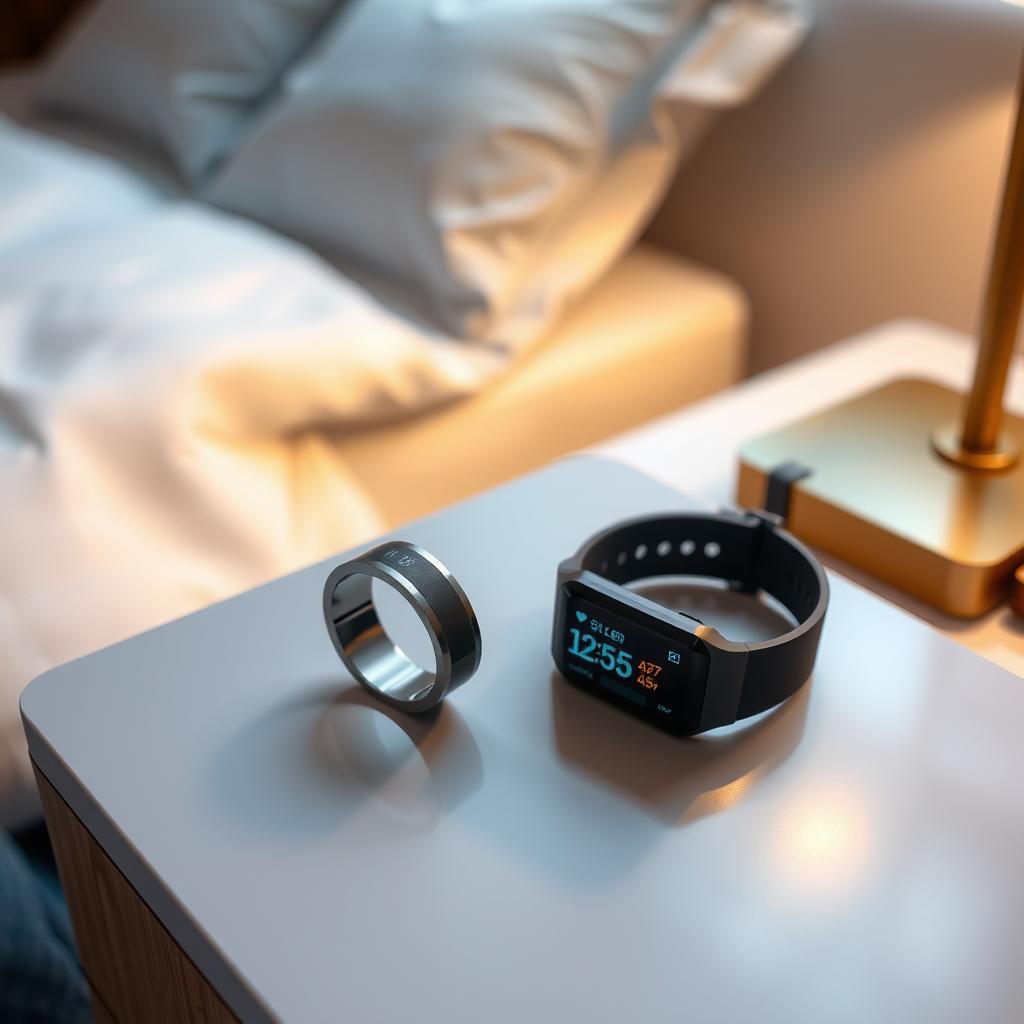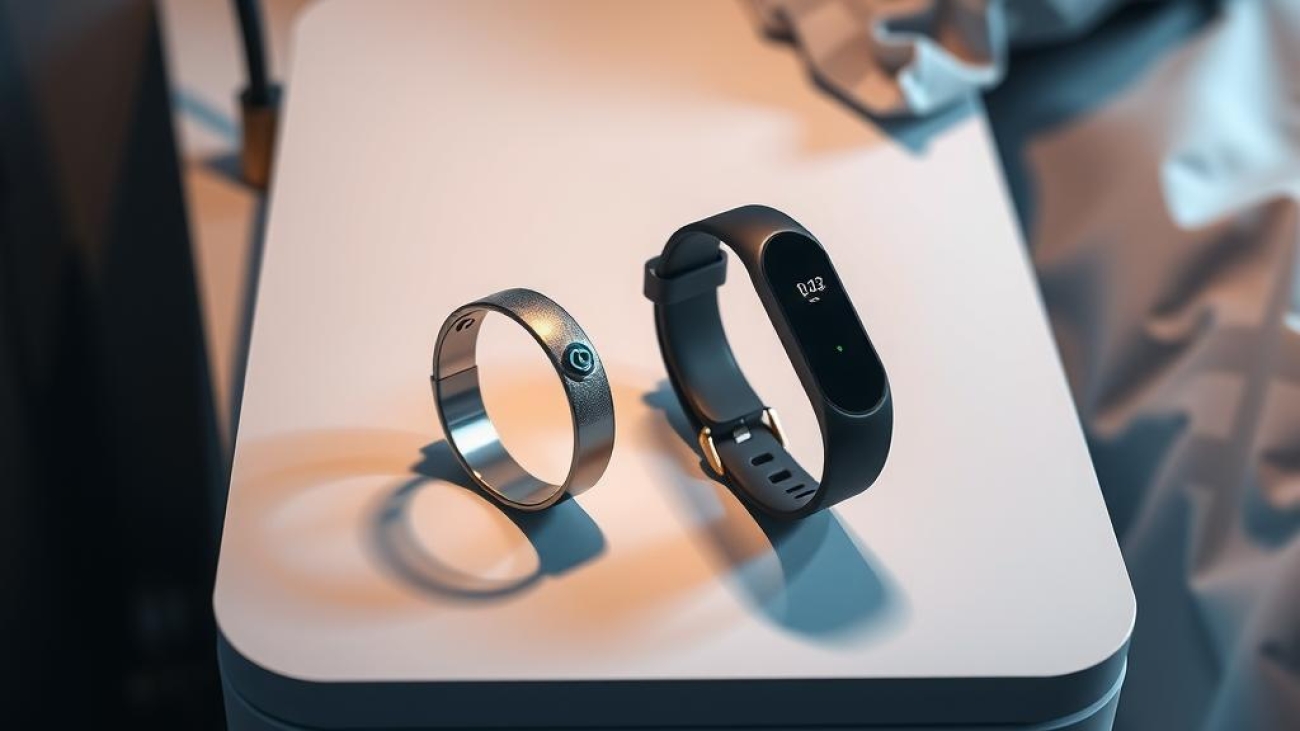In the realm of health monitoring and fitness tracking, a significant question looms: how accurately can wearable technology gauge one of our most vital activities—sleep? As consumers increasingly turn to smart devices for insights into their well-being, two contenders have emerged at the forefront: the smart ring and the wristband. Each offers unique features and promises to enhance sleep tracking, but which device truly delivers when it comes to accuracy?
The core value of this discussion lies in understanding how these wearables measure up against each other in terms of sleep quality assessment. The emergence of advanced technologies has made it possible for users to gain unprecedented insight into their nightly rest patterns. However, with various options available on the market, discerning between them becomes crucial for those seeking reliable data analysis regarding their sleep habits.
Both the smart ring and wristband employ sophisticated sensors designed to monitor heart rates, movements, and even blood oxygen levels throughout the night. Yet, subtle differences in design and functionality may lead to varying degrees of precision in sleep tracking outcomes. This article aims not only to delve into an accurate comparison between these two devices but also explore how they cater to different user needs within the broader context of wearable technology.
As individuals strive for improved wellness through enhanced health monitoring tools, understanding which device aligns better with personal preferences is essential. By examining factors such as comfort during use while sleeping or ease of integration with existing fitness routines, readers will uncover valuable insights that could influence their purchasing decisions.
Stay tuned as this exploration unfolds—discover whether a sleek smart ring or a versatile wristband stands out as your ultimate ally in achieving restful nights filled with restorative slumber!

Key Insights:
-
Device Design and Comfort: The design and comfort of a Smart ring versus a wristband can significantly influence user experience. The sleek form factor of the Smart ring allows for unobtrusive wear during sleep, which may enhance its accuracy in capturing sleep data. In contrast, while traditional wristbands provide versatility as fitness trackers, their bulkiness could potentially affect how well they monitor sleep quality.
-
Data Collection Methods: Both the Smart ring and wristband utilize advanced sensors for tracking sleep patterns; however, the methodologies can differ. The Smart ring employs cutting-edge technology to gather more specific metrics such as heart rate variability and oxygen saturation levels throughout the night. Conversely, wristbands often focus on basic movement tracking to estimate sleep stages, leading to potential discrepancies in accuracy comparison between these two smart devices.
-
User Experience and Analytics Interpretation: Ultimately, understanding how users interpret the analytics provided by each device is crucial for effective health monitoring. The detailed insights delivered by a Smart ring, including personalized recommendations based on comprehensive data analysis, may cater better to individuals seeking deeper insights into their sleep quality. Meanwhile, those using a wristband might appreciate its straightforward approach but could miss out on nuanced information essential for optimizing rest strategies.

The Evolution of Health Management
Wearable Technology: A Game Changer in Sleep Tracking
In recent years, the landscape of health management has experienced a profound transformation, largely driven by advances in wearable technology. Devices like the smart ring and various wristbands are at the forefront of this evolution, providing users with unprecedented insights into their sleep patterns. With increasing awareness surrounding the importance of sleep quality for overall health, these smart devices have become essential tools for individuals seeking to monitor and improve their nightly rest. Research indicates that nearly one-third of adults suffer from sleep-related issues, prompting many to turn to innovative solutions provided by modern technology. By employing sophisticated sensors and algorithms, these wearables track vital metrics such as heart rate variability, movement during sleep cycles, and even ambient light exposure. This data not only facilitates better understanding but also enables personalized recommendations aimed at enhancing sleep hygiene.
Accuracy Comparison: Traditional Methods vs Wearable Devices
The accuracy comparison between traditional methods of monitoring sleep—like polysomnography—and contemporary wearable devices raises intriguing questions about reliability and accessibility in health monitoring. While polysomnography remains the gold standard for diagnosing sleep disorders due to its comprehensive nature involving EEG readings and other physiological measurements, it is often impractical for regular use due to cost and complexity. In contrast, wearables such as wristbands offer an accessible alternative without sacrificing too much precision when tracking key indicators related to sleep quality. Recent studies have demonstrated that many smart devices can achieve remarkably high levels of accuracy when compared against clinical measures; however, discrepancies may arise depending on individual user behavior or device calibration settings. For instance, while a smart ring might excel in heart rate tracking during REM cycles, it may fall short in detecting subtle movements indicative of lighter stages of slumber.
Enhanced Data Analysis: Insights Into Sleep Quality
Enhanced data analysis capabilities afforded by wearable technology contribute significantly to improving users’ understanding of their own sleeping habits over time. Through continuous monitoring facilitated by products like smart rings or advanced wristbands equipped with machine learning algorithms, individuals can access detailed reports outlining trends related to their daily activities versus nightly restfulness — allowing them greater control over their health outcomes. These insights empower users not only with quantitative data but also qualitative reflections on how lifestyle choices impact their overall well-being; whether it’s adjusting caffeine intake or modifying evening routines based on prior night’s findings about deep versus light slumber phases becomes crucial information gleaned from analytics provided through these smart devices.
The Future Outlook: Integration Into Holistic Health Strategies
The future outlook for wearable technology within the realm of health management appears promising as more consumers recognize its potential benefits—especially concerning effective strategies for improving both fitness tracking performance alongside enhanced focus on holistic approaches towards bettering mental wellness via optimized sleeping patterns captured through devices like wristbands or compact yet powerful smart rings. As acceptance grows amongst broader populations regarding integrating tech-driven solutions into daily life routines geared toward fostering healthier living standards continues unabatedly onward trajectory points towards integration across diverse healthcare systems emphasizing preventative care models leveraging real-time biometric feedback channels available via personal electronics—a trend poised further catalyzed by developments ensuring interoperability among various platforms enabling seamless sharing invaluable datasets collected thereby enriching collective knowledge base surrounding optimal human functionality relating back core aspects vitality encompassing restful rejuvenation necessary thrive modern existence amidst ever-evolving challenges presented contemporary lifestyles today!
Smart Rings: Advanced Sleep Metrics
Unveiling the Technology Behind Sleep Quality Measurement
The evolution of wearable technology has ushered in innovative devices like the smart ring, designed to enhance health monitoring, particularly in sleep tracking. Unlike traditional wristbands, which often rely on bulkier designs and can be cumbersome during nighttime use, smart rings offer a sleek and discreet alternative. Their compact size does not compromise their functionality; rather, it enhances user comfort while providing accurate data analysis essential for understanding sleep quality. The advanced sensor technology embedded within these rings plays a crucial role in achieving high precision in measuring various aspects of sleep.
Smart rings utilize an array of sensors that monitor heart rate variability, body temperature fluctuations, and even blood oxygen levels throughout the night. This multifaceted approach allows users to gain insights into their sleeping patterns by providing comprehensive metrics on different stages of sleep—light, deep, and REM (Rapid Eye Movement) cycles. By comparing data from a wristband or other wearable devices traditionally used for fitness tracking with that obtained from smart rings, consumers may notice significant differences in accuracy when analyzing their overall health metrics related to restfulness.
What sets apart smart rings from other smart devices is not just their design but also the sophisticated algorithms employed to process collected data effectively. These algorithms are capable of identifying trends over time through continuous monitoring while adapting to individual behaviors—offering personalized feedback on how lifestyle choices impact overall sleep quality. Additionally, many models feature Bluetooth connectivity that allows them to sync seamlessly with smartphones or tablets where users can access detailed reports about their sleeping habits via dedicated applications.
Moreover, advancements in materials have led manufacturers to create durable yet lightweight options that cater specifically to overnight wearability without causing discomfort or skin irritation—a common concern among wearers of heavier fitness trackers or wristbands. The integration of advanced biometric sensors within these stylish accessories demonstrates innovation at its finest as they blend aesthetics with functionality seamlessly.
In summary, as more individuals seek effective solutions for improving their well-being through enhanced sleep tracking, products like the smart ring emerge as frontrunners due largely to superior accuracy compared with conventional alternatives such as wristbands. With ongoing technological improvements paving the way forward in this realm of wearable tech—from refined sensor capabilities down through better design considerations—it becomes increasingly evident that these small yet powerful tools will play an integral role not only in personal health management but also toward fostering greater awareness around our collective need for restorative sleep practices.
The Rise of Wristbands in Sleep Tracking
Unveiling the Functionality and Limitations
The advent of wearable technology has revolutionized how individuals monitor their health, with wristbands becoming a favored choice for fitness tracking. These devices offer various functionalities, one significant feature being sleep tracking. Users can benefit from the capability to analyze sleep patterns and receive insights into their rest quality through data analytics provided by these smart devices. Reports indicate that many users appreciate features such as duration monitoring—how long they spend asleep—and the cycles of light versus deep sleep experienced throughout the night. However, despite these advantages, limitations persist regarding accuracy. While some wristbands deliver compelling data on overall sleep time, discrepancies often arise when comparing their readings against those from more sophisticated devices such as a smart ring, which may utilize advanced sensors for enhanced precision in detecting different stages of sleep.
User Experiences: A Mixed Bag
Exploring Real-World Feedback on Performance
User experiences with wristband-based sleep tracking illustrate an array of sentiments ranging from satisfaction to frustration. Owners frequently report ease-of-use and comfort during wear, making them suitable companions for nightly routines; however, feedback reveals mixed results concerning performance accuracy compared to other wearables like the smart ring. Many users find that while their wristbands provide adequate initial insights into sleeping habits—such as average hours slept—they fall short when it comes to detailed analysis over prolonged use or precise measurements during restless nights or periods of wakefulness. Some customers mention that external factors like movement caused by partners can skew results further and negatively impact reliability metrics associated with basic models of wristbands.
Comparative Insights: Accuracy Matters
Distinguishing Between Wearable Technologies
When delving deeper into performance comparisons between traditional wristbands and cutting-edge alternatives like the smart ring, notable differences emerge regarding sleep quality assessments offered by each device type. Research indicates that while both technologies aim at enhancing user comprehension about health monitoring, they do not measure up equally in terms of precision within specific metrics such as REM cycle detection or heart rate variability during nocturnal phases—for instance, several studies suggest that a smart ring tends to yield superior accuracy due to its placement near vital physiological indicators (e.g., pulse reading). In contrast, most entry-level wristbands may struggle particularly under conditions where accurate heart rate assessment is crucial for evaluating stress levels affecting restful slumber.
Future Prospects: Evolving Technology
Innovations on the Horizon
As wearable technology continues evolving at an unprecedented pace, innovations are expected across both traditional wristband designs and emerging products like smart rings aimed specifically at improving functionality related to sleep tracking. Industry experts predict increased integration capabilities allowing synchronization between multiple types of wearables leading toward enhanced holistic health management platforms capable not only delivering detailed analyses but also recommending personalized lifestyle adjustments based on comprehensive usage data collection trends observed over time—a concept gaining traction among consumers seeking improved control over individual well-being practices centered around sufficient restorative rest cycles essential in today’s fast-paced world.
Conclusion: Finding Balance in Technology
Embracing Both Options
In summary, adopting either traditional wristbands or innovative options such as smart rings presents unique advantages alongside inherent limitations tied primarily to differing levels of technological sophistication employed within each product category targeted towards aiding effective sleep quality enhancement efforts amongst users worldwide looking actively engage in fostering better overall wellness outcomes through informed decisions rooted firmly grounded upon solid objective measurement principles underpinning modern-day wearable tech advancements serving critical roles therein.
Frequently Asked Questions:
Q: How do the Smart ring and wristband differ in sleep tracking capabilities?
A: The primary difference lies in their design and technology. The Smart ring utilizes advanced sensors that provide detailed metrics on sleep stages, heart rate variability, and overall sleep quality. In contrast, traditional wristbands offer a more generalized approach to sleep tracking, focusing on total hours slept and basic movement patterns.
Q: Which device is more comfortable for overnight wear during sleep monitoring?
A: Comfort can vary based on personal preference; however, many users report that the lightweight form factor of the Smart ring allows for a less intrusive experience compared to bulkier wristbands. This comfort level can significantly influence the accuracy of data collected during rest periods as it minimizes disruptions caused by uncomfortable wear.
Q: Can either device integrate with other health apps for comprehensive data analysis?
A: Yes, both devices generally support integration with various health applications. The wristband, often designed as a fitness tracker, may sync seamlessly with platforms focused on physical activity metrics. Meanwhile, the Smart ring tends to offer deeper insights into specific health metrics like recovery scores and stress levels alongside its robust sleep quality assessments—providing users with a holistic view of their wellness journey through effective data analysis.

Add a Comment